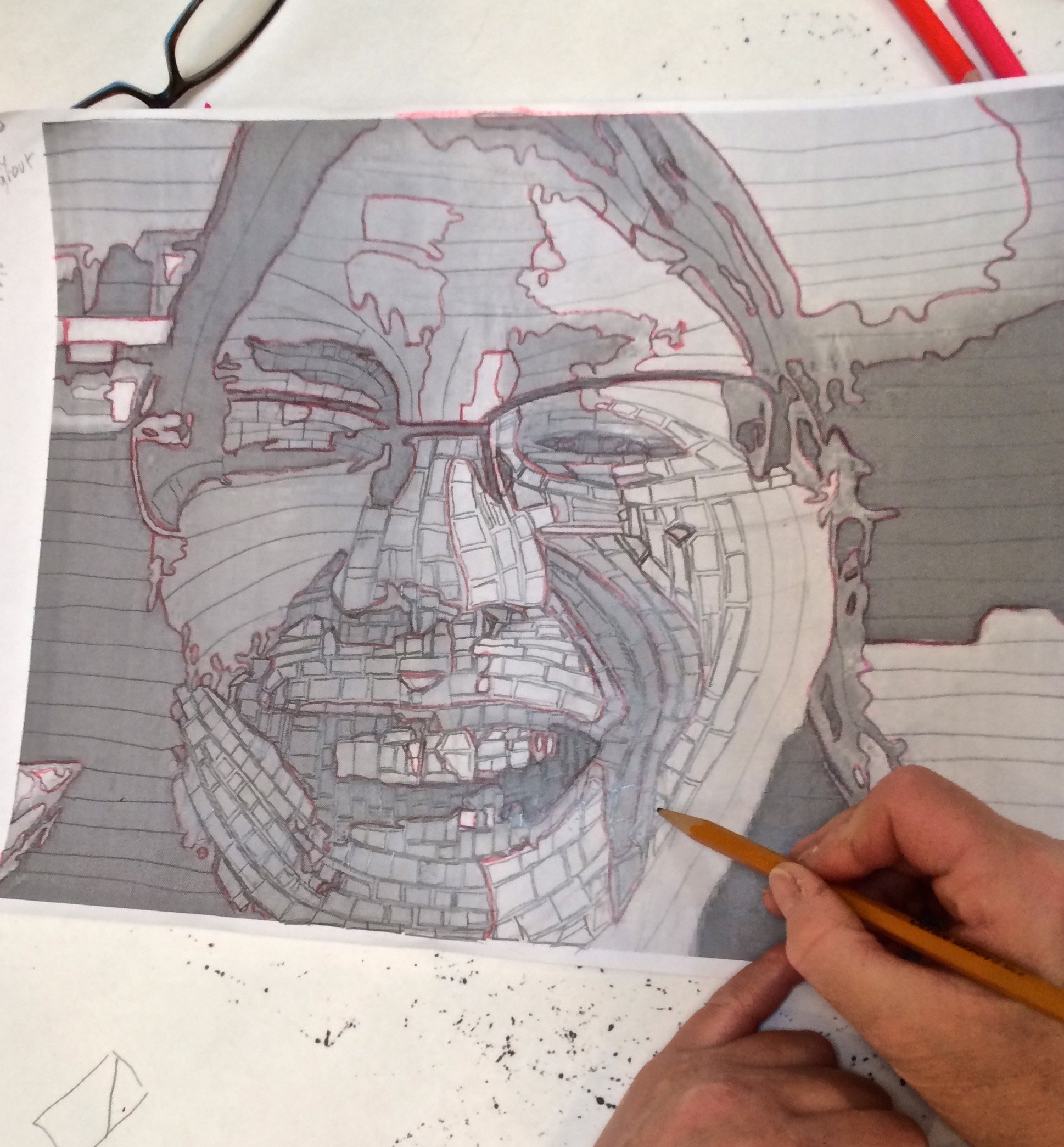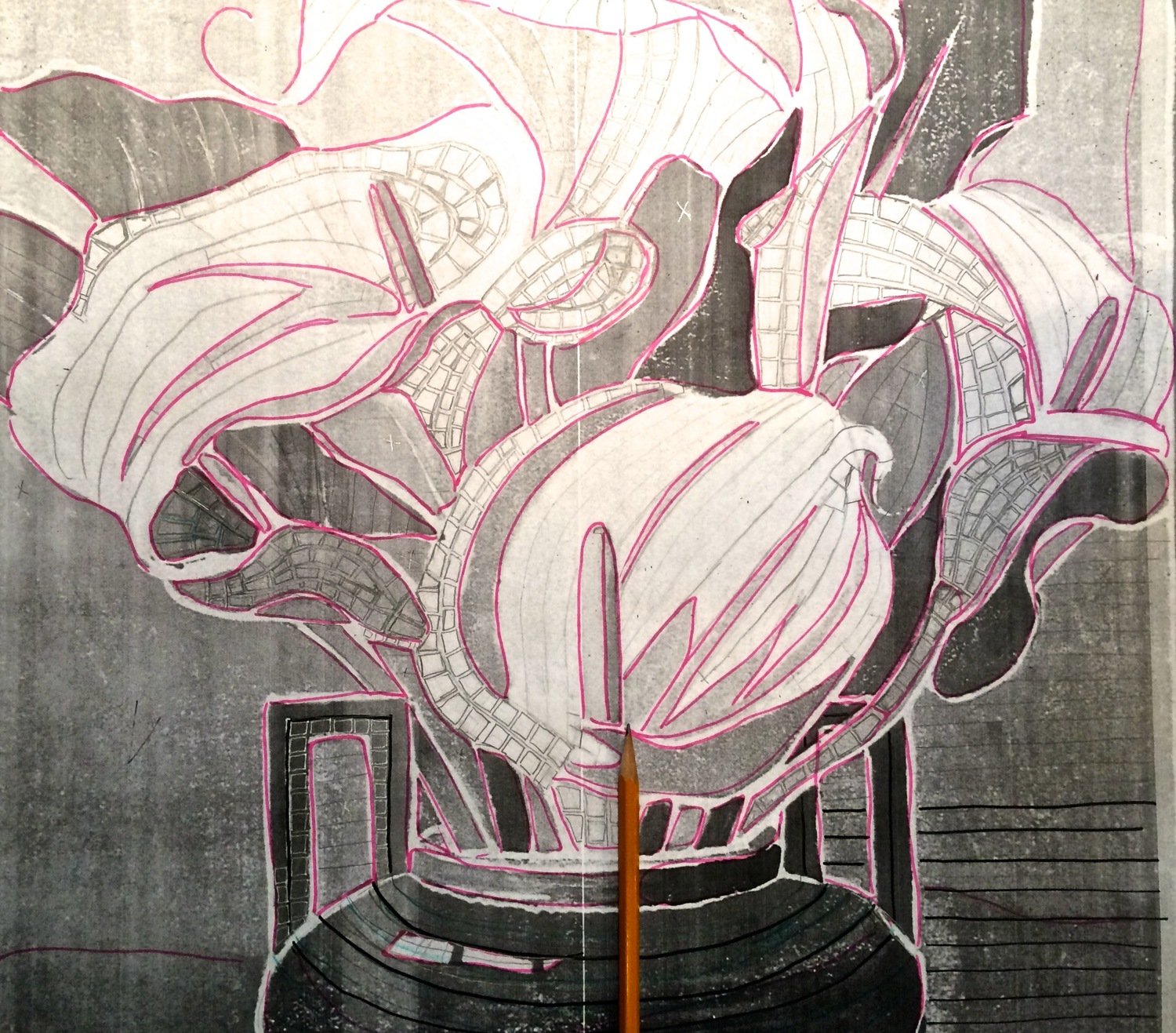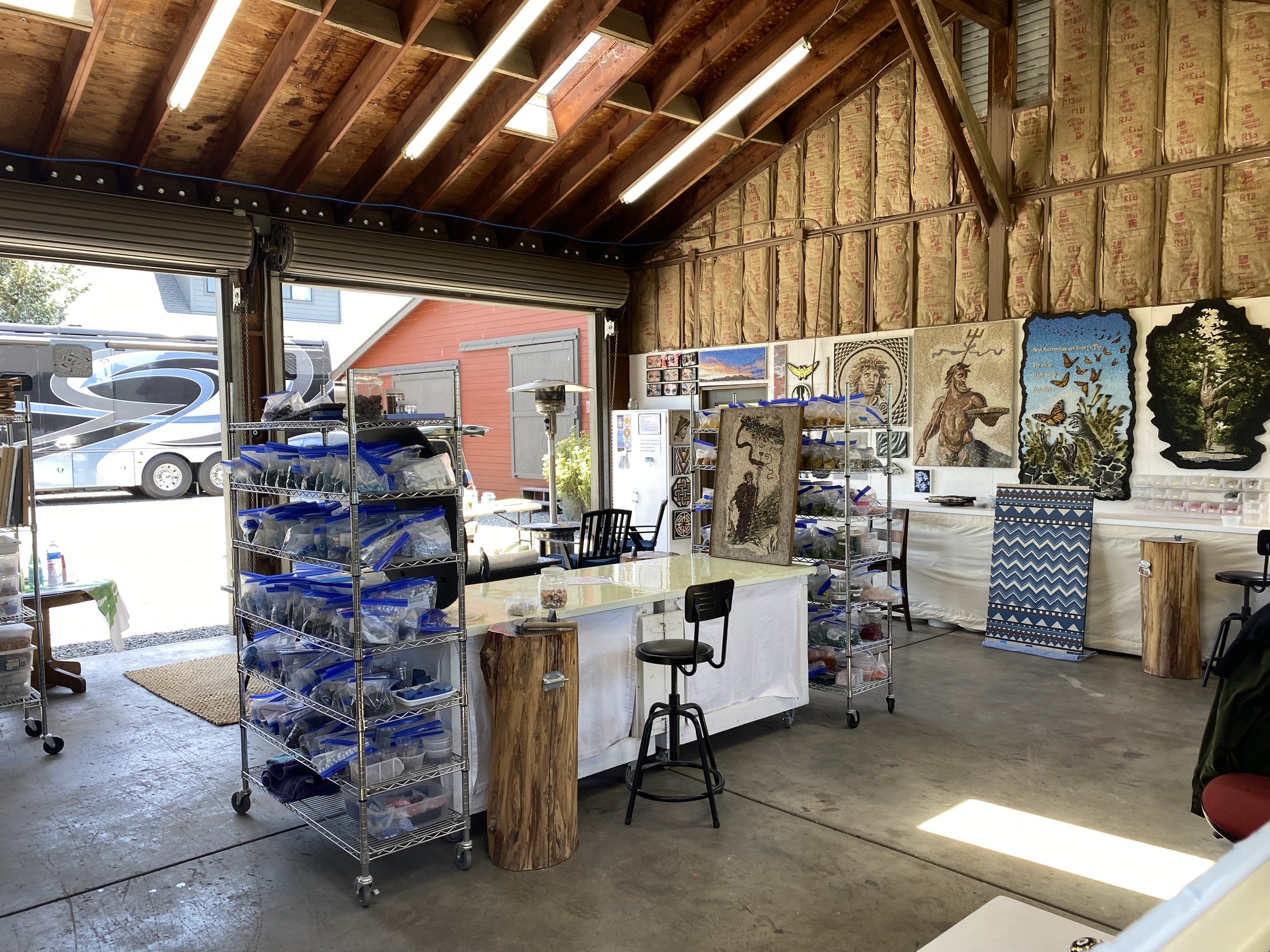The Ravenna Method & Andamento - 5-Day Intensive
MKMosaics Studio
7750 Giusti Rd
forestville, CA 95436
Daily-10am-6pm with 1 hr for Lunch
October 1-5, 2025
Semi-Private rate: $800
Private rate: $1150
Materials Fees: $ varies according to reproduction selection
Register: kruzline@gmail.com
This course is appropriate for beginners.
This is an intensive course with an immersive schedule. Please note there is no opportunity to make up missed time.
My studio is a bit rustic. It is a gorgeous setting on a winery but is not a luxury facility. For instance, the restroom is located in the winery’s office trailer which is approximately 120 ft away outside my studio and has a couple stairs.
In this course students will begin by learning the basic principles of “Ancient Roman Andamento” technique. Following this, students will apply these principles while reproducing a segment of an ancient mosaic using The Ravenna Method; one of the several “Direct” methods for making mosaics. During the last two days, while finishing final processes with their reproduction, students will dive deeper into Andamento techniques. These studies will be on paper involving progressively challenging exercises. Finally, students explore and apply these principles to their own personal work ideas on paper. Students are asked to bring in their own designs, photos, or images to work with for this exercise. Figurative, realistic, and abstract images can work.
This class is for the serious mosaic student who is ready to knuckle down, work hard, and discover how the classical principles of mosaic can be of value in developing your mosaic work. This is not a socializing course. I want you to have fun but you will be VERY busy as will everyone, and this is to be respected. If you need a lot of socializing during class hours, this is NOT the course for you.
This is an intensive course with an immersive schedule. Please note there is no opportunity to make up missed time.
Some of the class topics covered include:
Mosaic terminology
Origins of the Ravenna method and step-by-step processes
Ancient cutting techniques with hammer and hardie and proper alignment of body and tools
Developing and printing a design to a temporary clay bed
“Andamento”, “Value” and classic principles of laying tesserae for both subject and backgrounds
Mosaic Materials, Substrates, and Binders: preparation, properties, and appropriate selection
Demos of alternate “finishing” options for mosaic including “cocciopesto” treatment
Demo of mounting a hardie in base
Several other Direct Method techniques
______________________________________________
“Andamento” refers to the “course” or lines that tesserae are laid in to make up a mosaic. Andamento was developed in harmony with the natural way our eyes perceive form and line. In “figurative’ work the andamento mirrors the natural form of the subject, whereas andamento in “abstract” work tends to be a bit freer, however, no less important to understand in creating harmonious perception for the viewer’s eye.
This course tends to lean a bit more toward figurative andamenti, but also touches on the importance of how it can be used in contemporary and abstract mosaics as well.
Studying how to draw and plan out Andamento and tessellation of mosaic lines is of great value before creating a mosaic, and, as with most disciplines, continued practice of these principles eventually becomes more 2nd-nature and really pays off in the successful expression of mosaic work.
____________________________________________________
"The "Ravenna Method” (or “Direct Method into Temporary Binder”)is one of several “direct” methods, and was developed when ancient mosaics started to have trouble with their original mortar settings and needed to be restored or transferred to other locations. It is a combination of the ancient “Direct Method into Permanent Binder” method and the restoration methods developed at that time.
The Ravenna Method applies ancient methods of laying tesserae, is useful in contemporary applications, and is still used by many Italian professional mosaicists today. In the Ravenna method, materials are set into a temporary bed of lime paste or clay where they can be moved and changed until the final effect is achieved. The temporary bed of clay or lime paste remains moist for weeks and months; meaning it can be left and returned to when you are ready to work again. Once complete the mosaic is transferred to a permanent mortar bed.
Some of the main advantages of The Ravenna Method are:
- Changes are easily made by removing tesserae directly from the moist clay
- You are always working on the right side or face of the mosaic and as it will look when finished.
- The mosaic can be worked on while sitting upright and can be viewed from a distance to see how it is reading to the eye
____________________________________________________
Instruction in the use of Hammer and Hardie (the traditional tools for cutting smalti and stone) is covered, practiced, and used with stone and Italian smalti glass to reproduce a portion of a classical mosaic. Hammers and Hardies are provided. We do not use nippers in this class. If you can hit a nail with a hammer you should be able to learn these tools.
____________________________________________________
Students will choose a reproduction image from the list I send them after registration.
There are over 50 reproduction kit subjects available, however, not all of them are achievable in the class time. Therefore, the list I send you to choose from will not include all of the choices available at https://www.mkmosaics.com/ancient-reproduction-kits-1
After the course students will have the ability to order further reproduction kits from Michael to continue their practice.
Once you select your reproduction image from the list I send you, you will pay me for the “reproduction kit” and the downloadable and printable paper components of these reproductions will be sent to you to take to a printer like Kinko’s/Fedex to be printed in their working size.
I will then order your “reproduction kit” directly from diMosaico.com and either have it shipped to you to bring with you to class, or it may be possible to have it shipped to me to hold for you for your class.
Therefore, it is essential to sign up for your course at latest 30 days in advance so that all of these components have time to arrive to you.
Students will have 2 1/2 days to complete cutting and laying their reproduction. We then begin the extraction and setting process for your reproductions over the final two days, at the same time as moving forward to the Andamento studies and exercises and applications.
Students will leave with the knowledge of how to lay a mosaic using The Ravenna Method as well as Andamento technique and how to apply it to your own ideas.
______________________________________________________________________________________________________________________________
Here is a link to a video by Michael Kruzich's teacher Luciana Notturni in her Ravenna school The Mosaic Art School explaining the Ravenna method: http://www.youtube.com/watch?v=dVqnd0MCcW0
______________________________________________________________________________________________________________________________
Ground Rules
Classroom Etiquette & Expectations
As adults and creatives, I believe we all thrive in an environment built on mutual respect, discipline, and shared purpose. I hold a strong commitment to classroom etiquette and basic professional courtesy—not to be rigid, but to ensure that our time together is productive, focused, and respectful of everyone’s efforts.
On Punctuality
Over many years of teaching, I’ve observed a recurring challenge: consistent, uncommunicated lateness. While a rare, unforeseen delay is completely understandable, habitual tardiness—especially without notice—is disruptive and inconsiderate, both to me as your instructor and to your fellow students.
In my own professional background, especially in the dance world, punctuality is non-negotiable. If you were late, you were often already replaced. That perspective has shaped how I run my classes. I start on time, and I do not go back to cover missed material. The beginning of class is when key concepts are introduced, and being present from the start matters.
If showing up on time is something you regularly struggle with, this may not be the right space for you. I’m being direct here because I want to set clear expectations and avoid misunderstandings later on.
What I Expect From You
• Arrive early whenever possible. A few minutes ahead of time shows respect for the group and allows you to settle in mentally and physically before we begin.
• Be present both in the morning and after lunch. These are often key teaching times, and I need your full attention then.
• Understand that repeated lateness—especially without communication—will likely result in a conversation, and possibly being asked not to return.
Professional Courtesy in the Space
• Phones should be on silent or vibrate. If you need to take a call, please step outside.
• Respect the space and each other—we may be working in tight quarters at times. Be kind, be aware, and look out for each other.
• Focus during class. While artistic communities thrive on dialogue and shared ideas, constant talking or social conversation during instruction can be distracting. I welcome collaboration and creative exchange, but please keep in-the-moment discussions brief and relevant. If you need frequent side conversation to stay engaged, this may not be the most suitable learning space.
Final Thought
This is a space for serious, committed learners—artists who are ready to show up with discipline, maturity, and curiosity. I’m here to guide and support your growth, but I also expect you to meet me halfway by honoring the structure that allows that growth to happen.
Let’s create a respectful, energized space where we can all do our best work.
Classes at MKMosaics Studio are kept to a maximum of 7 students at this time. To run, a class must have a minimum amount of 2-3 students unless it is a private course at a private rate.
Please do not delay in signing up. There are only 7 available spots for any course.
A rule of thumb is to be signed up at least 30 days before the course to facilitate acquiring necessary materials etc.
Many people come in from all over the United States for class and need to make travel arrangements.
Class is a go when the minimum amount of students sign up.
If the minimum amount of students is not met one month before the course, I will contact any student signed up to ask if they would like to pay the “private” rate and keep the class as scheduled. If the single student does not wish this, the class will be canceled and they will have the option to reschedule or receive a full refund.
Tuition is refundable up to 30 days before the start of the class.
Cancellations/refunds after 30 days prior will be considered on a case-by-case basis.
Please get in touch with me at kruzline@gmail.com to make arrangements.
What Michael's students say...














